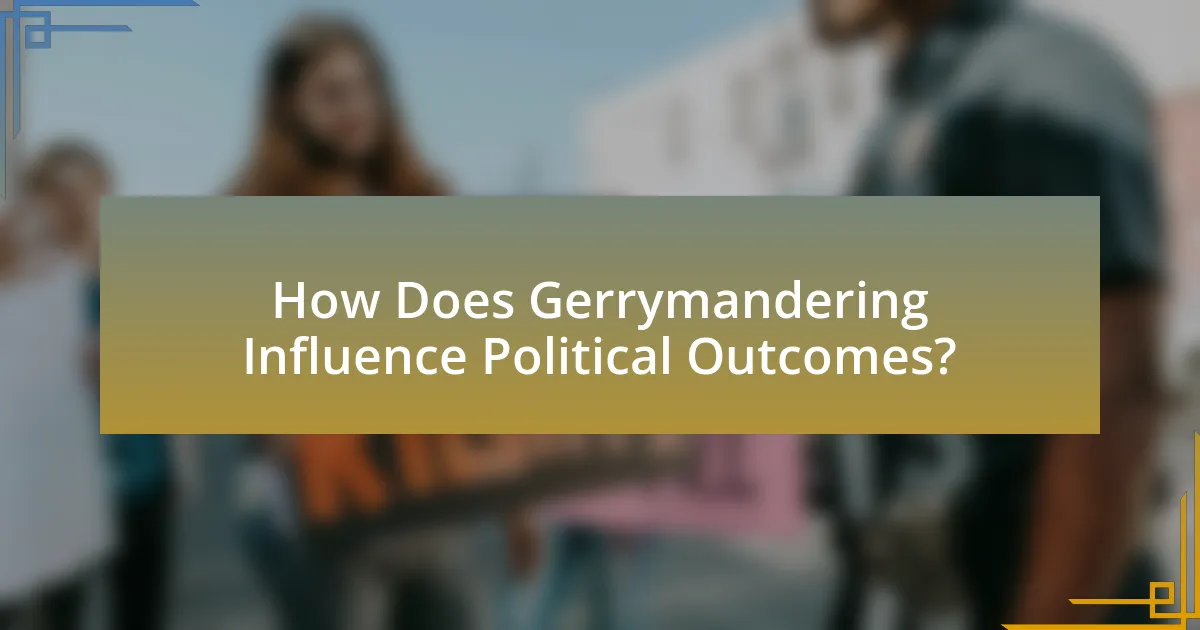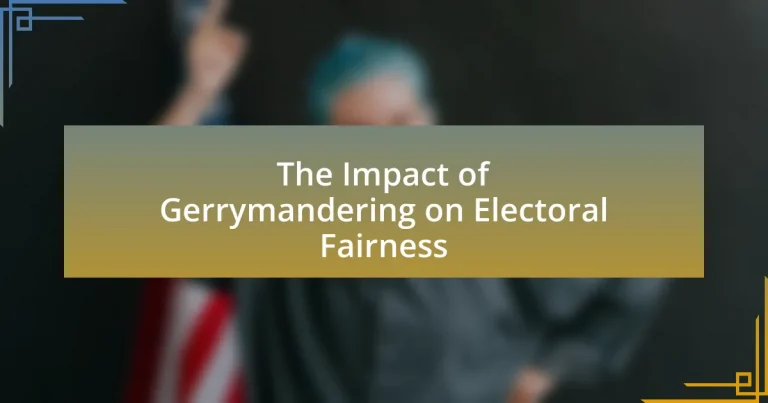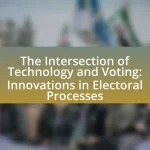Gerrymandering is the strategic manipulation of electoral district boundaries to benefit a specific political party, significantly impacting electoral fairness and representation. This article explores the historical origins of gerrymandering, its evolution over time, and the various methods employed, such as cracking and packing. It examines key legal cases that have shaped gerrymandering laws, the role of technology in modern practices, and the consequences of unfair electoral practices on voter turnout and minority representation. Additionally, the article discusses potential solutions to combat gerrymandering, including independent redistricting commissions and algorithmic mapping, emphasizing the importance of electoral fairness in a democratic society.

What is Gerrymandering and How Does it Affect Electoral Fairness?
Gerrymandering is the manipulation of electoral district boundaries to favor a particular political party or group. This practice affects electoral fairness by distorting representation, allowing parties to secure more seats than their overall vote share would warrant. For instance, in the 2012 U.S. congressional elections, Republicans won 49.2% of the popular vote but secured 55% of the seats due to gerrymandered districts, illustrating how district design can skew electoral outcomes.
What are the historical origins of gerrymandering?
Gerrymandering originated in the early 19th century, specifically in 1812, when Massachusetts Governor Elbridge Gerry signed a bill that redistricted the state to benefit his political party. This practice involved manipulating electoral district boundaries to favor one party over another, exemplified by the creation of a district that resembled a salamander, which led to the term “gerrymander.” The historical context reveals that political motivations drove the redistricting efforts, as parties sought to maximize their electoral advantages. The term has since evolved to describe similar practices across the United States, highlighting its enduring impact on electoral fairness and representation.
How has gerrymandering evolved over time?
Gerrymandering has evolved from simple district manipulation in the early 19th century to sophisticated techniques using advanced data analytics today. Initially, gerrymandering involved drawing irregular district lines to favor a political party, as seen in the 1812 Massachusetts redistricting by Governor Elbridge Gerry. Over time, the practice became more systematic, particularly after the Voting Rights Act of 1965, which aimed to protect minority voting rights. This led to the creation of majority-minority districts, which, while intended to enhance representation, also facilitated partisan gerrymandering. In recent years, the advent of technology and big data has allowed for more precise targeting of voters, enabling parties to optimize district boundaries for electoral advantage. Studies, such as those by the Brennan Center for Justice, highlight that this evolution has increasingly undermined electoral fairness, leading to disproportionate representation and voter disenfranchisement.
What key cases have shaped gerrymandering laws?
Key cases that have shaped gerrymandering laws include Baker v. Carr (1962), which established the principle of “one person, one vote,” and allowed federal courts to intervene in redistricting issues. Another significant case is Shaw v. Reno (1993), where the Supreme Court ruled that racial gerrymandering is unconstitutional if it is the predominant factor in drawing district lines. Additionally, Rucho v. Common Cause (2019) determined that partisan gerrymandering claims are non-justiciable, meaning federal courts cannot rule on them, thus significantly impacting the legal landscape surrounding gerrymandering. These cases collectively influence how gerrymandering is addressed in the legal system, shaping electoral fairness.
What are the different methods of gerrymandering?
The different methods of gerrymandering include “cracking,” “packing,” and “kidnapping.” Cracking involves dispersing a particular voting bloc across multiple districts to dilute their voting power, while packing concentrates a specific group into a single district to minimize their influence in surrounding areas. Kidnapping refers to redrawing district lines to include or exclude specific populations, often displacing communities to alter electoral outcomes. These methods manipulate district boundaries to favor one political party over another, undermining electoral fairness.
How do packing and cracking techniques work?
Packing and cracking techniques are strategies used in gerrymandering to manipulate electoral district boundaries for political advantage. Packing involves concentrating a particular demographic group into a single district to minimize their influence in surrounding districts, thereby reducing their overall electoral power. For example, if a political party can pack a large number of voters from the opposing party into one district, they can secure that district while diluting the opposing party’s influence in adjacent districts. Cracking, on the other hand, involves dispersing a demographic group across multiple districts to prevent them from achieving a majority in any of those districts. This technique ensures that their voting power is weakened, as their votes are spread too thinly to impact election outcomes. Evidence of these techniques can be seen in various electoral maps where districts are drawn in irregular shapes to achieve these objectives, ultimately affecting electoral fairness by skewing representation in favor of one party over another.
What role does technology play in modern gerrymandering?
Technology plays a crucial role in modern gerrymandering by enabling precise data analysis and mapping techniques that allow political parties to manipulate electoral district boundaries effectively. Advanced software tools, such as Geographic Information Systems (GIS), facilitate the analysis of demographic data, voting patterns, and geographic features, which can be used to create districts that favor one party over another. For instance, the use of algorithms and machine learning models allows for the optimization of district shapes to maximize electoral advantage, often resulting in irregularly shaped districts that dilute the voting power of certain groups. This manipulation has been documented in various studies, including a 2018 report by the Brennan Center for Justice, which highlights how technology has transformed the gerrymandering process, making it more efficient and harder to detect.
Why is electoral fairness important in a democracy?
Electoral fairness is crucial in a democracy because it ensures that all citizens have an equal opportunity to participate in the political process and have their votes counted equally. This principle fosters trust in the electoral system, promotes political stability, and encourages civic engagement. Historical evidence shows that when electoral fairness is compromised, as seen in instances of gerrymandering, voter disenfranchisement occurs, leading to skewed representation and undermining the legitimacy of elected officials. For example, the 2010 redistricting in several U.S. states resulted in districts that favored one political party, illustrating how manipulation of electoral boundaries can distort the democratic process and diminish public confidence in governance.
How does electoral fairness impact voter representation?
Electoral fairness directly enhances voter representation by ensuring that electoral processes reflect the true preferences of the electorate. When electoral systems are fair, each vote carries equal weight, leading to outcomes that accurately represent the diverse views within a population. For instance, studies have shown that in systems with fair districting, such as those without gerrymandering, the percentage of votes received by a party closely aligns with the percentage of seats they obtain in the legislature. This alignment fosters greater accountability and responsiveness from elected officials, as they must consider the interests of a broader constituency. In contrast, gerrymandering distorts this relationship, often resulting in disproportionate representation where certain groups are overrepresented while others are marginalized, undermining the principle of equal representation.
What are the consequences of unfair electoral practices?
Unfair electoral practices lead to significant consequences, including the erosion of public trust in the democratic process. When electoral systems are manipulated, such as through gerrymandering, the representation of voters becomes skewed, resulting in outcomes that do not reflect the true will of the populace. For instance, a study by the Brennan Center for Justice found that gerrymandering can distort electoral outcomes, allowing a party to secure a disproportionate number of seats relative to its share of the vote. This manipulation undermines the principle of fair representation, leading to voter disenfranchisement and decreased civic engagement. Ultimately, these practices can destabilize the political landscape, fostering polarization and conflict among different societal groups.

How Does Gerrymandering Influence Political Outcomes?
Gerrymandering influences political outcomes by manipulating electoral district boundaries to favor one political party over another. This practice can lead to disproportionate representation, where a party secures more seats than its overall vote share would suggest. For example, in the 2012 U.S. House elections, Democrats received 1.4 million more votes than Republicans nationwide, yet Republicans won 33 more seats, illustrating how gerrymandering can distort electoral fairness. Additionally, studies show that gerrymandered districts often result in less competitive elections, reducing voter engagement and skewing policy outcomes in favor of the dominant party.
What effects does gerrymandering have on election results?
Gerrymandering significantly skews election results by manipulating district boundaries to favor one political party over another. This practice can lead to disproportionate representation, where a party secures a majority of seats despite receiving a minority of the overall vote. For instance, in the 2012 U.S. House elections, Democrats received 1.4 million more votes than Republicans nationwide, yet Republicans won 33 more seats, illustrating how gerrymandering can distort electoral outcomes. Additionally, gerrymandering can entrench political power, reduce competition, and diminish voter turnout, as individuals may feel their votes carry less weight in heavily manipulated districts.
How does gerrymandering affect party dominance in elections?
Gerrymandering significantly affects party dominance in elections by manipulating district boundaries to favor one political party over another. This practice allows the dominant party to concentrate or dilute opposition voters, thereby maximizing their electoral advantage. For instance, in the 2012 U.S. House elections, gerrymandering contributed to the Republican Party winning 49% of the popular vote while securing 55% of the seats, illustrating how district manipulation can distort representation. Such strategic redistricting undermines electoral fairness, leading to outcomes that do not accurately reflect the electorate’s preferences.
What is the impact of gerrymandering on voter turnout?
Gerrymandering negatively impacts voter turnout by creating districts that dilute the voting power of certain groups, leading to voter apathy and disengagement. Research indicates that when voters perceive their votes as less meaningful due to manipulated district boundaries, they are less likely to participate in elections. For instance, a study by the Brennan Center for Justice found that gerrymandered districts often result in lower turnout rates, particularly among marginalized communities, as these voters feel their representation is compromised. This trend illustrates how gerrymandering can undermine electoral participation and fairness.
How does gerrymandering affect minority representation?
Gerrymandering negatively impacts minority representation by manipulating electoral district boundaries to dilute their voting power. This practice often results in minority groups being spread across multiple districts or concentrated into a single district, which can minimize their overall influence in elections. For instance, a study by the Brennan Center for Justice found that gerrymandering can lead to significant underrepresentation of racial and ethnic minorities in legislative bodies, as districts are drawn to favor one political party over another, often at the expense of minority voters. This systematic alteration of district lines undermines the principle of fair representation, leading to a lack of equitable political power for minority communities.
What challenges do minority groups face due to gerrymandering?
Minority groups face significant challenges due to gerrymandering, primarily through the dilution of their voting power. Gerrymandering manipulates electoral district boundaries to favor one group over another, often resulting in minority communities being split across multiple districts. This fragmentation reduces their ability to elect representatives who reflect their interests and needs. For instance, a study by the Brennan Center for Justice highlights that in states with aggressive gerrymandering, minority voters often find themselves in districts where they constitute a minority, leading to underrepresentation in legislative bodies. This systematic disenfranchisement perpetuates inequalities and undermines the principle of fair representation in the electoral process.
How can gerrymandering lead to political polarization?
Gerrymandering can lead to political polarization by creating electoral districts that favor one political party over another, thereby reducing competition. This manipulation of district boundaries often results in “safe” seats for incumbents, which diminishes the incentive for candidates to appeal to a broader electorate. Research indicates that in heavily gerrymandered states, voters are more likely to be sorted into districts that reflect their partisan preferences, leading to increased ideological homogeneity. For instance, a study by the Brennan Center for Justice found that gerrymandering has contributed to a significant rise in partisan polarization in Congress, as representatives from gerrymandered districts are less likely to engage in bipartisan cooperation.

What Solutions Exist to Combat Gerrymandering?
Solutions to combat gerrymandering include independent redistricting commissions, algorithmic mapping, and legal reforms. Independent redistricting commissions, utilized in states like California and Arizona, remove partisan influence by assigning the task of drawing district lines to non-partisan entities. Algorithmic mapping employs computer algorithms to create fair district maps based on population data, ensuring equitable representation. Legal reforms, such as the introduction of stricter criteria for district drawing, have been implemented in various states to enhance transparency and fairness in the redistricting process. These solutions aim to create more balanced electoral outcomes and improve overall electoral fairness.
What reforms have been proposed to address gerrymandering?
Reforms proposed to address gerrymandering include the establishment of independent redistricting commissions, the implementation of algorithmic mapping tools, and the adoption of proportional representation systems. Independent redistricting commissions aim to remove partisan influence by allowing non-partisan bodies to draw district lines, as seen in states like California and Arizona, which have reported increased electoral competitiveness. Algorithmic mapping tools utilize mathematical models to create fair district maps based on population data, reducing human bias. Proportional representation systems, which allocate seats based on the percentage of votes received, can mitigate the effects of gerrymandering by ensuring that minority parties have a fair chance of representation, as evidenced in countries like Germany.
How do independent redistricting commissions work?
Independent redistricting commissions work by removing the power of political parties from the redistricting process, thereby aiming to create fairer electoral maps. These commissions are typically composed of nonpartisan members who are selected through a transparent process, ensuring that the drawing of district lines is based on objective criteria rather than partisan interests. For example, states like California and Arizona have implemented independent commissions that utilize demographic data and community input to establish district boundaries, which helps to minimize gerrymandering. Research has shown that states with independent redistricting commissions tend to have more competitive elections and better representation, as evidenced by the increased number of contested races in these states compared to those without such commissions.
What role does public awareness play in combating gerrymandering?
Public awareness plays a crucial role in combating gerrymandering by mobilizing citizens to advocate for fair electoral practices. Increased awareness leads to greater public scrutiny of district maps and the redistricting process, which can pressure lawmakers to adopt more transparent and equitable practices. For instance, studies have shown that states with active citizen engagement and awareness campaigns have implemented independent redistricting commissions, resulting in fairer electoral outcomes. According to a report by the Brennan Center for Justice, public advocacy has been instrumental in passing reforms in several states, demonstrating that informed citizens can effectively challenge gerrymandering and promote electoral fairness.
What are the best practices for ensuring fair electoral maps?
The best practices for ensuring fair electoral maps include utilizing independent redistricting commissions, applying clear and consistent criteria for district boundaries, and employing technology and data analysis to minimize gerrymandering. Independent redistricting commissions, which have been adopted in states like California and Arizona, reduce partisan influence by involving non-partisan experts in the map-drawing process. Clear criteria, such as population equality, contiguity, and respect for community boundaries, help maintain fairness and transparency in the mapping process. Additionally, using advanced data analysis techniques, such as algorithmic mapping, can identify and eliminate biased district shapes, as demonstrated in studies by the Brennan Center for Justice, which highlight the effectiveness of these methods in promoting electoral fairness.
How can technology be used to create fairer district maps?
Technology can be used to create fairer district maps through advanced algorithms and data analysis tools that ensure equitable representation. Geographic Information Systems (GIS) enable the visualization and analysis of demographic data, allowing for the identification of communities and the drawing of district lines that reflect population distributions accurately. Additionally, machine learning algorithms can optimize districting by minimizing partisan bias and ensuring compliance with legal standards, such as the Voting Rights Act. Studies have shown that using these technologies can lead to more balanced electoral outcomes, as evidenced by the implementation of algorithm-driven mapping in states like California, which has resulted in districts that better represent the electorate’s diversity.
What steps can citizens take to advocate for electoral fairness?
Citizens can advocate for electoral fairness by actively participating in grassroots movements that promote redistricting reform. Engaging with organizations focused on ending gerrymandering, such as the League of Women Voters or Common Cause, allows citizens to collaborate on initiatives aimed at creating fair district maps. Additionally, citizens can contact their elected representatives to express support for legislation that establishes independent redistricting commissions, which have been shown to reduce partisan bias in districting, as evidenced by states like California and Arizona. Public awareness campaigns, including social media outreach and community forums, can further educate others about the importance of fair electoral processes and mobilize collective action.


